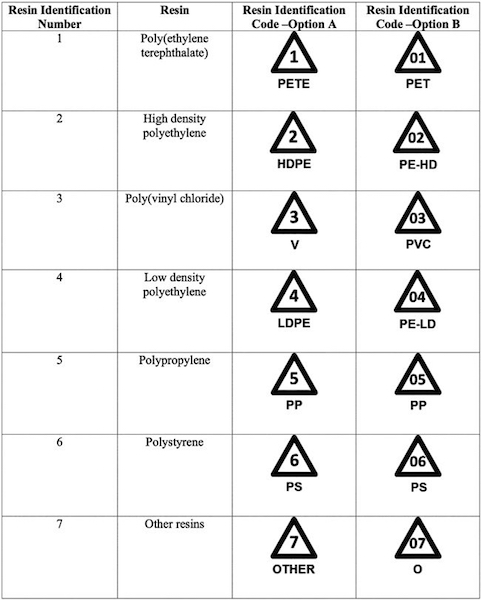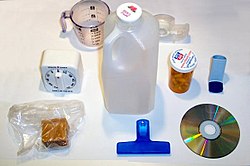Resin identification code
A resin identification code (RIC) is a symbol embedded on plastic products, used to sort plastic waste for recycling. They consist of a triangle of clockwise "chasing arrows", around a number indicating what type of resin it is made of (01 for PET, 02 for HDPE, 03 for PVC, 04 for LDPE, 05 for polypropylene, 06 for polystyrene, or 07 for Other). These symbols were originally created in 1988 by the Plastics Industry Association in the United States, amid growing concerns about plastic pollution.[1] Since 2008, they are administrated by the ASTM and comprise the technical standard D7611/D7611M-21 "Standard Practice for Coding Plastic Manufactured Articles for Resin Identification".[2] The European Commission Decision 97/129/EC "Identification System For Packaging Materials" extends this system with recycling codes for other materials like batteries, paper, and glass.[3] Despite their similarity to the recycling symbol, resin codes do not indicate whether a product is recyclable.[1] They are frequently misinterpreted by consumers, and contribute to wishcycling (the contamination of recycling bins with unrecyclable goods).[1][4] At the US Environmental Protection Agency's recommendation, a 2013 revision to the ASTM standard replaced the "chasing arrows" with a solid equilateral triangle, but the old symbols are still more widely used among manufacturers. History The Society of the Plastics Industry (SPI) first introduced the system in 1988 as the "Voluntary Plastic Container Coding System". The SPI stated that one purpose of the original SPI code was to "Provide a consistent national system to facilitate recycling of post-consumer plastics."[5] The system has been adopted by a growing number of communities implementing recycling programs, as a tool to assist in sorting plastics. In order to deal with the concerns of recyclers across the U.S., the RIC system was designed to make it easier for workers in materials recovery and recycling facilities to sort and separate items according to their resin type.[citation needed] Plastics must be recycled separately, with other like materials, in order to preserve the value of the recycled material, and enable its reuse in other products after being recycled. When a number is omitted, the arrows arranged in a triangle resemble the universal recycling symbol, a generic indicator of recyclability. Subsequent revisions to the RIC have replaced the arrows with a solid triangle, in order to address consumer confusion about the meaning of the RIC, and the fact that the presence of a RIC symbol on an item does not necessarily indicate that it is recyclable any more than its absence means the plastic object is necessarily unrecyclable. In 2008, ASTM International took over the administration of the RIC system and eventually issued ASTM D7611—Standard Practice for Coding Plastic Manufactured Articles for Resin Identification.[6] In 2013 this standard was revised to change the graphic marking symbol of the RIC from the "chasing arrows" of the Recycling Symbol to a solid triangle instead. Possible new codesModifications to the RIC are currently being discussed and developed by ASTM's D20.95 subcommittee on recycled plastics.[7] In the U.S. the Sustainable Packaging Coalition has also created a "How2Recycle" label[8] in an effort to replace the RIC with a label that aligns more closely with how the public currently uses the RIC. Rather than indicating what type of plastic resin a product is made out of, the four "How2Recycle" labels indicate whether a plastic product is
The "How2Recycle" labels also encourage consumers to check with local facilities to see what plastics each municipal recycling facility can accept. ListThe different resin identification codes are part of the Unicode block called Miscellaneous Symbols and have the following codes: ♳ (U+2673), ♴ (U+2674), ♵ (U+2675), ♶ (U+2676), ♷ (U+2677), ♸ (U+2678), and ♹ (U+2679). ♺ (U+267A).
Below are the RIC symbols after ASTM's 2013 revision[12][13] CriticismIn the United States, use of the RIC in the coding of plastics has led to ongoing consumer confusion about which plastic products are recyclable. When many plastics recycling programs were first being implemented in communities across the United States, only plastics with RICs "1" and "2" (polyethylene terephthalate and high-density polyethylene, respectively) were accepted to be recycled. The list of acceptable plastic items has grown since then,[2] and in some areas municipal recycling programs can collect and successfully recycle most plastic products regardless of their RIC. This has led some communities to instruct residents to refer to the form of packaging (i.e. "bottles", "tubs", "lids", etc.) when determining what to include in a curbside recycling bin, rather than instructing them to rely on the RIC.[14] To further alleviate consumer confusion, the American Chemistry Council launched the "Recycling Terms & Tools" program to promote standardized language that can be used to educate consumers about how to recycle plastic products. However, even when it is technically possible to recycle a particular plastic, it is often economically unfeasible to recycle it, and this can mislead consumers into thinking that more plastic is recycled than really is.[15] In the U.S. in 2018, only 8.5% of plastic waste was recycled.[16] See also
References
External linksWikimedia Commons has media related to Resin identification codes. |
||||||||||||||||||||||||||||||||||||||||||||||||||||||||||||||||||||||






































